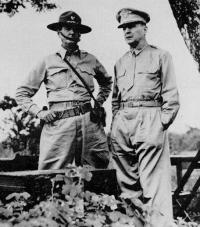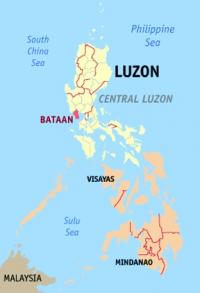
Generals Wainwright (l) & MacArthur.

Map showing location of Bataan Peninsula

U.S. General Edward P. King, Jr. discusses surrender.
This week, 70 years ago, Maj. General Edward P. King, Jr. surrendered a combined force of 75,000 starving American and Filipino soldiers defending the Bataan Peninsula on Luzon Island in the Philippines. The rocky peninsula is bounded on the west by the South China Sea, Subic Bay to the northwest and Manila Bay to the east. The Bataan Province, which occupies the Peninsula, currently has a population of 662,000. The southern tip of the peninsula is a 40-minute jet-ferry ride from the Philippine capital of Manila.
On December 8, 1941 - the day after the attack on Pearl Harbor - the Japanese launched air strikes against the air fields in the Philippines, catching most of the American warplanes inexplicably unprepared and unprotected. The American air power in the Philippines was destroyed. These attacks were accompanied by landings on Batan Island - not to be confused with Bataan Peninsula - located 120 miles off the coast of Luzon. On December 10, landings on northern Luzon Island by the 14th Imperial Japanese Army, under the command of General Masaharu Homma, began. Two days later, elements of the 14th Army’s 16th Division landed on southern Luzon. The 16th Army, commanded by Lt.Gen Hosaku Imamura, began landing on Mindanao Island on December 19th. The 14th Army’s 48th Division and a regiment of the 16th Division, and approximately 90 tanks landed on Luzon Island on the east coast of Lingayen Gulf on December 22nd. On December 24, the rest of 16th division came ashore on southern Luzon Island.
Even though his forces outnumbered the Japanese, General Douglas MacArthur ordered that those forces retreat to the Bataan Peninsula, where they could - and would be - more easily trapped and starved into submission. Manila was declared an "open city" on December 24, 1941 and occupied on January 2, 1942. By January 6, 1942, the combined American and Filipino Defensive Force was trapped on the Bataan Peninsula. The original plan, developed before the war, envisioned a holding action until the U.S. Navy could sail to the rescue. However, when the plan was put into action, most of the U.S. Pacific Fleet lay at the bottom of Pearl Harbor.
On March 11, 1942, General Douglas MacArthur, who maintained his headquarters on the Island of Corregidor, left his starving army and relocated to Australia, leaving command of the Philippine defense forces to Lt. Gen. Jonathan M. Wainwright, IV. For this, he earned the sobriquet "Dugout Doug." In an attempt to put the "proper" spin on it, the U.S. government awarded the Medal of Honor to the departed General. Until Congress authorized the Medal for Theodore Roosevelt, Sr., eleven years ago, MacArthur and his father, Arthur, were the only father and son to be awarded the Medal.
On April 9, 1942, Maj. Gen. King surrendered his 75,000 sick and emaciated soldiers to the Japanese. This is now a national holiday in the Philippines, known as the "Day of Valor." It was the largest surrender of U.S. forces in history. Another 10,000 had been killed. The cost to the Japanese was 7,000 killed and 12,000 wounded. By this time, the soldiers were reciting the following poem -
"We’re the Battling Bastards of Bataan,
No momma, no pappa, no Uncle Sam,
No aunts, no uncles, no cousins, no nieces,
No pills, no planes, no artillery pieces,
And nobody gives a damn."
The Japanese were unprepared for this many prisoners. Thus began the 80 mile "Bataan Death March" to POW camps. Now the enemy turned its attention to Corregidor. Until it was captured, the Japanese could make no use of Manila’s harbor - the finest in the Orient.
Corregidor was defended by 56 coastal guns and mortars. The largest, of which there were two, were 12-inch guns with a range of 29,000 yards. There were also two 12-inch mortars. The island also had 76 anti-aircraft guns, ranging from 50-caliber to three inch. The defenders numbered 11,000 and included two battalions of the 4th Marine Regiment, assorted U.S. Navy personnel and about 1500 American and Filipino Scouts.
The Japanese pounded the island, day and night, with their artillery and air force. It finally reached a crescendo on May 4, when 16,000 shells and bombs fell on the island. By the end of the day, many of the defenders’ guns had been destroyed. The next day Maj. Gen. Kureo Tanaguchi led 790 soldiers onto the island, shortly after midnight. Another 880 soldiers followed at 5:30 A.M. When three Japanese tanks arrived at 9:30 A.M., the jig was up. General Wainwright radioed the President that, "There is a limit of human endurance, and that point has long been past." The General signaled the Japanese that he wished to surrender the Corregidor garrison. About 1:30 p.m. on May 6, 1942, he was taken to Bataan to meet with General Homma, who arrived in a shiny Cadillac and demanded, in perfect English, that General Wainwright surrender all Allied forces in the Philippines. When the American general refused, General Homma replied that he would take him back to Corregidor to do, "...what you damn well please...." General Wainwright acceded to the Japanese’ demand and, at midnight, executed the surrender document.
Another 11,000 American and Filipinos marched into captivity. When Bataan and Corregidor surrendered, 11 Navy, and 66 Army, nurses also became guests of the Emperor. Allied casualties in the defense of Corregidor were 800 dead and 1,000 wounded, while 900 of the Emperor’s soldiers were killed and 1,200 wounded.
On October 20, 1944, the effort to recapture the Philippines began when American soldiers landed on Leyte Island. Landings were made on Mindoro Island on December 15, 1944. The first units came ashore on Luzon on January 9, 1945.
On January 23, 1945, the effort to retake Corregidor commenced with daily bombing by the United States Army Air Force. During the next month, 3,000 tons of bombs were dropped on the island. On February 13, the Navy joined the fray and for three days pounded the island. On February 16th, the 13th Air Force dropped 1,000 paratroopers onto the island. Finally, on March 1, 1945, the Island was declared secured. Two days later, Manila was also declared secured. The Japanese defenders of Fort Drum, near Corregidor were finally eliminated on April 13, 1945. Mindanao was invaded four days later.
General Wainwright was liberated from Japanese captivity in August 1945, by the Red Army, in Manchuria. He attended the surrender ceremony aboard the U.S.S. Missouri in Tokyo Bay on September 2, 1945. Upon returning to the United States, a ticker-tape parade was held in his honor in New York City on September 13, 1945, after which he was presented with the Medal of Honor. General MacArthur, who had received his for leaving, opposed the award to the general he left behind.
General Homma, who suffered disgrace because the conquest had not been accomplished quickly enough, retired. After the war, he was charged with war crimes related to the Bataan Death March, convicted by an American military tribunal, sentenced to die, and on April 3, 1946, executed by firing squad. General Imamura joined the Chinese Nationalists fighting the Communists. When the Nationalists were defeated, in 1949, he committed suicide.
The cost of the Philippines’ involuntary participation in the Japanese’ "Greater East Asia Co-Prosperity Sphere" was 1,000,000 Filipino deaths. On July 4, 1946, it became an independent Republic, even though the Japanese had granted it "independence" in 1943, and in 1944 it had declared war against the U.S. That government was headed by José P. Laurel, Sr.
NEXT WEEK: DOOLITTLE’S RAID - "THIRTY SECONDS OVER TOKYO"
Mr. Wimbrow writes from Ocean City, Maryland, where he practices law representing those persons accused of criminal and traffic offenses, and those persons who have suffered a personal injury through no fault of their own. He can be reached at wimbrowlaw@beachin.net
«Go back to the previous page.


